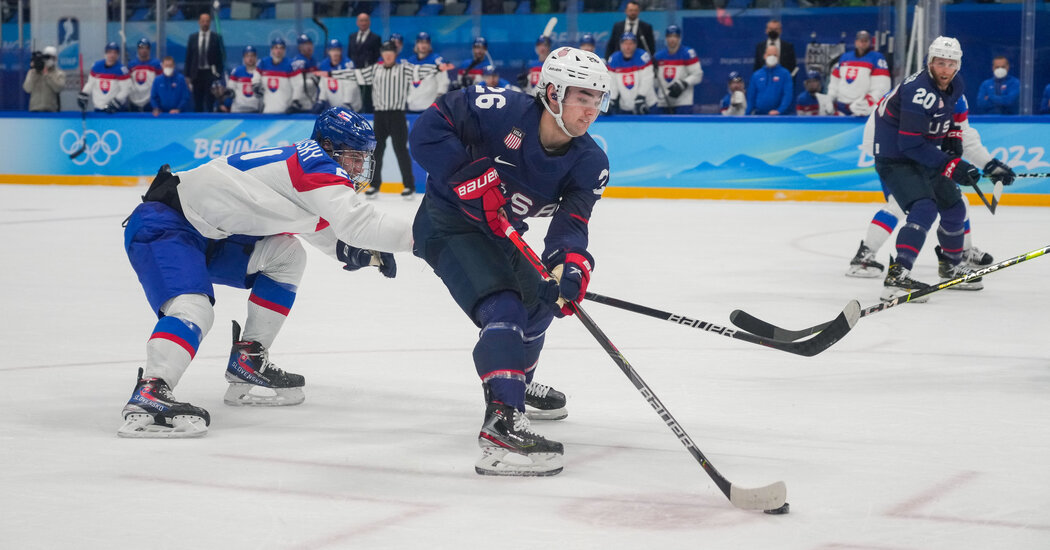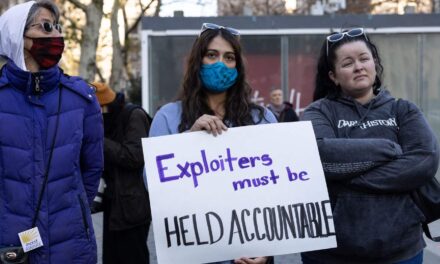
U.S. Men’s Hockey Is Eliminated in Loss to Slovakia

Image

Slovakia seemed out of time.
Its men’s hockey team had scored first in its quarterfinal against the United States at the Beijing Games. But even after surrendering the lead, it had kept the Americans, the Olympic tournament’s top seed, within a goal all afternoon.
But as Marek Hrivik patrolled near the American crease in the final minute, Slovakia still needed a goal. It arrived with about 44 seconds to play, sending the game to overtime and, eventually, to a shootout. There, Slovakia won, 3-2, to end the United States’ improbable ambition to capture an Olympic gold medal with its youngest team in decades.
“We played really well our first three games, and then this was kind of our first kind of bad game,” U.S. forward Ben Meyers said. “And now we’re done. I don’t really know what to say at this point.”
2
United States
3
Slovakia
Brendan Brisson
Sean Farrell
Matt Knies
Nathan Smith
Andy Miele
Libor Hudacek
Michal Cajkovsky
Michal Kristof
Peter Cehlarik
The United States did not arrive in Beijing as much of a favorite. Stripped of its star power by the N.H.L.’s decision to withhold its players from the Olympic tournament, its men’s team was a last-minute and decidedly unglamorous assembly of college athletes and aging former pros. Only one member of the team had any previous Olympic experience. But it powered through the preliminary round, pummeling China, outdistancing Canada and surviving Germany to emerge as an unlikely gold-medal contender.
The quarterfinal against Slovakia felt like a gateway game of sorts, a matchup against a team that had already lost twice but still had mettle, and a No. 9 ranking in the world. The Slovaks also had a deeply experienced coach, Craig Ramsay, and the talents of Juraj Slafkovsky, a 17-year-old forward who had captivated the tournament — and N.H.L. scouts — with his scoring.
The Americans encountered his prowess early, after the puck raced around the edge of the rink and made its way to Slafkovsky. He took aim for his team’s sixth shot of the afternoon, and the goal horn sounded almost instantly.
A bit of slick passing by the Americans produced the goal by Nick Abruzzese that tied the score before the end of the period, though. And midway through the second period, a fast-rotating Sam Hentges slid the puck into the net to give the United States the lead.
There were chances to build on it; the one the Americans might regret most was their inability to produce a goal when presented with a two-man advantage early in the third period. “When you’ve got a five-on-three in that scenario and you don’t capitalize on it, you’re giving that other team a lot of hope,” Coach David Quinn said.
Or just enough, at least.
Image
As regulation time ticked away, Slovakia pulled its goalie to bolster its attack. Then Hrivik struck, maneuvering the puck just past Strauss Mann.
Overtime yielded no goals. The United States would, for the second straight Games, face a shootout in a quarterfinal game.
Three Americans failed to score. So did three Slovaks.
After Nathan Smith became the fourth victim of Patrik Rybar’s goaltending, Peter Cehlarik took the puck. A first-time Olympian, the 26-year-old forward charged down the ice. To Mann’s eye, he shifted the angle of his shot and launched the puck fast.
“I thought I was all over it,” Mann said, “and didn’t feel it and then didn’t hear the board.”
Slovakia had scored.
Men’s QuarterfinalsFinal |
OT | SO | T | |||
|---|---|---|---|---|---|---|
|
Slovakia |
1 | 0 | 1 | 0 | 1 | 3 |
|
United States |
1 | 1 | 0 | 0 | 0 | 2 |
It was left to Andy Miele, the American captain, to save the United States at that point. But Rybar blocked his try — all five Americans failed to convert in the shootout — and his teammates poured off the bench, their earlier desperation now given way to celebration.
The Americans finished their third consecutive Olympics without a medal. Slovakia will meet Canada or Sweden in a semifinal on Friday.
“We played so hard,” said Ramsay, Slovakia’s venerable Canadian coach. “I think everyone felt we deserved it, and then it’s a matter of making it happen. The kids did it. They found a way.”
The American players had already trudged past by then, some laboring to avoid public tears. The tournament they had come to feel they could command — the tournament they had started to command — was over.
“It’s the quarterfinals of the Olympics,” Quinn said. “The other team is pretty damn good, too.”
Image
Alex Hall let out a whoop when he landed his last trick on the slopestyle course, and that was before the judges awarded him with what would be the winning score. It was, he said later, the best run of his life.
“Oh, I was stoked,” he said. “I couldn’t believe I just landed that.”
Hall was one of three Americans looking to crowd the medal stand at the men’s freestyle skiing slopestyle event, hoping that a European-centric field would not disrupt those plans.
Two of them did it: Hall won gold and Nick Goepper took silver on another sunny, below-zero day at Genting Snow Park. Jesper Tjader of Sweden won bronze.
In a competition where only a skier’s best score counted, Hall set the standard early with a 90.01 score on the first of three runs. Everyone else spent the frigid morning trying to match it, but no one did. Goepper came closest, on his second run, scoring 86.48.
“All right,” he said when the score popped up. “I’ll take it.”
Each of the Americans in the final arrived with high hopes and a stirring story. Goepper, 27, was looking to complete a full rainbow of medals, having won a bronze in 2014 and a silver in 2018. He has battled alcohol abuse and depression, opening up about his struggles after his 2018 performance in Pyeongchang, South Korea.
In an interview last month, Goepper said that he was glad that other Olympians seem increasingly willing to discuss their mental health.
Colby Stevenson, 24, was in a near-fatal car accident in 2016, late at night on a rural road in Idaho. He spent days in a coma, but recovered to return to the global circuit and win major events. At these Olympics, he won a silver medal in big air and was a contender for another medal in slopestyle.
Instead, he finished seventh, unable to cleanly land the run he imagined.
“Gave it everything I had,” he said after his last chance.
The day belonged to Hall. The 23-year-old was born in Alaska but grew up mostly in Switzerland, the son of professors at the University of Zurich. He did not have coaching until he was 16, when he was invited by the U.S. freeski team to train in Utah. For a time, he considered competing for Italy, where his mother is from.
That background, free from the constraints of coaching and youth competitions, imbibed him with a bit of a free spirit.
He was 16th in slopestyle at the 2018 Pyeongchang Winter Olympics, just as his career was taking off. He won a World Cup event that year and the X Games in 2019. He was third at last year’s world championships.
He is tall, well over six feet, but stands out on the slopes mostly for his originality.
“You’ll see him doing a whole bunch of taps and nose butters and creative ways to utilize the course,” U.S. freeski coach Dave Euler said of Hall in December. “He’s a very creative course user.”
The Olympic contest was the final showing for the slopestyle course, a standout venue — but a temporary one, made of snow — designed to look like a section of the nearby Great Wall. Its combination of rails, obstacles and jumps created a plethora of possibilities, but vexed some of the world’s best snowboarders and freeskiers. Hall and Goepper loved it.
“As soon as you standardize this sport, you’re going to kill it,” Goepper said. “So if you can leave the creativity and the artistry up to us, that is going to keep this sport fresh.”
It is why Hall was deemed the worthiest of Olympic champions. He has won big contests with dizzying spins, a ceaseless spin-to-win trend in both freeskiing and snowboarding that worries purists.
But on Wednesday, Hall brought a bag of technical tricks, hoping the judges would reward him for originality rather than rotations.
His last jump was one that he had landed only a couple of times before, even though it is really only a 900-degree rotation — half of what many other tricks are these days. As Hall described it, he spun one way in the air, stopped and spun the other way before landing.
That led to the whoop.
“I’ve always told myself, if I’m not having fun doing it, then there’s really no reason to do it,” Hall said. “So I might as well do what brings me all this joy.”
His smile was concealed by a mask, a hallmark of an Olympics held during a pandemic. But his eyes lit up below his ice-frosted eyebrows. He wore an American flag over his shoulders, and soon, a gold medal around his neck.
Image
Jessie Diggins returned Wednesday to the cross-country course at the Beijing Olympics, and to the event that made her a household name: the women’s team sprint. But with a new teammate and a different type of skiing style, Diggins could not write the same ending she crafted four years ago at the Pyeongchang Games.
Diggins and her new partner, Rosie Brennan, finished fifth in the race, unable to keep pace in the final kilometer with a lead group that sped away and claimed the medals. The German pair of Katharina Hennig and Victoria Carl won the gold, followed by the Swedes and the Russians.
When Diggins and Kikkan Randall won the event in 2018, they were the first Americans to earn a medal in cross-country skiing since 1976, ending one of the longest droughts in U.S. Olympic sports. Diggins, skiing the last leg, came from behind with a dramatic sprint to the line in the race’s final moments. It was memorably captured by an announcer’s call: “Here comes Diggins!”
That Olympic race was in the freestyle method, though, a style that most closely resembles the angled movements of roller skating, as opposed to the classical style, in which skiers must keep their skis parallel, often in manicured paths. Since the Olympic team sprint alternates styles every four years, Wednesday’s race was in the classical style.
Many skiers specialize in one discipline, and Diggins, who is far more comfortable skiing freestyle, spent much of her training trying to strengthen her classical technique. But she couldn’t make up the difference in expertise to successfully defend her gold medal.
In the team sprint, two skiers take turns in a relay, each skiing three legs of a 1.5-kilometer loop. It’s an endurance event hidden behind the “sprint” label. The semifinal was held two hours before the final, so each athlete in the final had sprinted around the loop six times before the medals were awarded.
Diggins arrived the Beijing Games as a leader of the U.S. team, a pathfinder who had showed other American cross-country skiers that they could compete with the Scandinavians who have long dominated the sport.
She led by example almost immediately, winning a bronze medal in the women’s freestyle sprint days after the Games began. It was the first individual Olympic medal won by an American woman in cross-country skiing. Brennan finished in fourth place; the combined American performance would have been unimaginable but a few years ago.
A few days later, Diggins and Brennan were part of the American team in the women’s 4×5-kilometer relay, a race split between classical and freestyle. With their teammates Hailey Swirbul and Novie McCabe, they placed sixth, behind a familiar European lineup.
At times, it seemed as if Diggins and Brennan would find themselves on the podium during Wednesday’s race. Both skiers excel in especially cold weather, and the conditions in Zhangjiakou delivered: The temperature at the start was 6 degrees Fahrenheit.
The Americans were in fourth place after the Brennan’s first leg, and Diggins, who excels on hills, powered to the lead on the second leg. Brennan and Diggins then stayed in the top four until the final exchange, when Diggins was unable to keep up in the final loop.
Image
A sample provided by a teenage Russian figure skater to an antidoping laboratory before the Beijing Games included three substances that are sometimes used to help the heart, according to a document filed in her arbitration hearing on Sunday.
The skater, Kamila Valieva, was cleared to continue competing in the Games by a panel of arbitrators on Monday even though a drug found in her system, trimetazidine, is on the list of drugs banned by global antidoping officials. Valieva, 15, provided the sample in December, but Russian antidoping officials said they had learned of her positive result only last week.
But according to documents reviewed by The New York Times and confirmed by someone who took part in the hearing, the Stockholm laboratory that carried out the examination of Valieva’s sample also found evidence of two other substances that can treat the heart but are not on the banned list. Valieva even listed them, Hypoxen and L-carnitine, on a doping control form.
The presence of trimetazidine in Valieva’s system may have been a mistake, Russian and Olympic officials have suggested. But the discovery of several substances in the sample of an elite athlete, especially one as young as Valieva, was highly unusual, according to a prominent antidoping official.
“It’s a trifecta of substances — two of which are allowed, and one that is not allowed,” Travis Tygart, the chief executive of the United States Anti-Doping Agency, said when told of the discovery. He added that the benefits of such a combination “seem to be aimed at increasing endurance, reducing fatigue and promoting greater efficiency in using oxygen.”
Earlier on Tuesday, a member of the International Olympic Committee’s executive board told reporters that Valieva’s positive result might have stemmed from a case of contamination with medication that her grandfather had been taking. And in testimony provided to an earlier hearing with Russian antidoping officials on Feb. 9, and later submitted as evidence in Sunday’s hearing in Beijing, Valieva’s mother said her daughter had been taking Hypoxen because of heart “variations.”
Valieva’s grandfather did not testify in the original hearing in Russia, but he did provide a video shot in a car, according to a portion of the document. In the video, the document said, he said that he had used trimetazidine periodically when he experienced “attacks” and showed a packet of the medication to the camera. Valieva’s mother said in her evidence in the Russian hearing that Valieva’s grandfather had accompanied the teenager to practice on a daily basis and had stayed with Valieva until her mother returned home from work.
L-carnitine, a naturally occurring substance that converts fat into energy, has surfaced in significant doping cases in the past. In 2019, Alberto Salazar, then a coach of some of the world’s top distance runners, was barred from the sport for four years in part for giving improper infusions of the substance to his athletes in an effort to bolster their performance. Salazar’s ban has since been made permanent.
L-carnitine is allowed when taken orally, Tygart said, but prohibited if given in large amounts by an infusion or IV because it could give an unfair performance-enhancing advantage. It was not clear how Valieva had taken the supplement, or the concentration in her sample.
The World Anti-Doping Agency, which is charged with policing doping in global sports, declined to comment on the document. The Russian antidoping agency, known as RUSADA, did not immediately reply to a request for comment.
The document said that Valieva had declared three products on a doping control form that was submitted with the now-failed test. Those products, the document said, were L-carnitine, Hypoxen and Supradyn, an immunity boosting supplement.
WADA had been among the organizations that pressed for Valieva’s suspension from competition — which would have effectively ended her Olympics — last week after revelations that she had tested positive became public the day after she helped Russia’s skaters win the gold medal in the team competition in Beijing.
Cleared to compete by a panel of arbitrators on Monday, Valieva returned to the ice on Tuesday and took first place in the short program of the women’s singles competition. She is widely expected to win the event after the free skate on Thursday.
An athlete who tests positive for a banned substance can request a further test of their “B” sample, which was collected at the same time as the original. Valieva has yet to ask for hers to be analyzed. She was part of a testing pool of Russian athletes that the International Testing Agency, the body responsible for the antidoping program at the Games, had sought tests for before the Games.
Image
She was a teenager, barely old enough to compete at the Olympics, and she did it almost flawlessly. After her last performance, to music from “Riverdance,” she pumped her fist and ran to her coach, who hoisted her onto his shoulders to wave to the crowd. There was no need to wait for her score to know she had won.
Then, abruptly, the dream was gone: She was stripped of her gold medal after she tested positive for a drug she didn’t know she had taken.
The athlete, Andreea Raducan — 16 years old when she and two other Romanian gymnasts swept the women’s all-around podium at the 2000 Olympics — became a cautionary tale for young prodigies who conquered their sport by doing everything the adults around them told them to. She had woken up with a cold, and the Romanian team doctor had given her an over-the-counter medication that she took without a thought. It contained pseudoephedrine, a banned substance.
The contrasts with the treatment of the Russian figure skater Kamila Valieva, who has been allowed to compete in Beijing despite having tested positive for a banned heart medication, are stark.
Valieva, 15, could ultimately receive the same punishment as Raducan. The International Olympic Committee has said that if she reaches the podium on Thursday, it will delay the medal ceremony until the case is resolved. The Court of Arbitration for Sport said that its decision to let her compete was not a final verdict but an acknowledgment that barring her would have consequences that could not be reversed if it ultimately cleared her of wrongdoing.
But the deference she has received thus far is hard to reconcile with the treatment of Raducan, who was only a year older and whose situation was even more ambiguous.
The heart medication found in Valieva’s urine sample, trimetazidine, is linked to greater energy and endurance, and the fact that it was accompanied by two additional substances that aren’t banned and that can sometimes be used to help the heart makes it appear less likely that she ingested trimetazidine unintentionally.
By contrast, few people argued that Raducan had taken pseudoephedrine for performance-enhancing purposes, or even that the substance had enhanced her performance. At the same Olympics, she tested clean for two other events in which she excelled: the team final, in which Romania won gold, and the vault final, in which she won silver. (She kept those medals.)
But for the purposes of Raducan’s all-around medal, the court concluded that her age and her intentions were irrelevant. It affirmed that the doctor was to blame and that Raducan was not, but it also said the rules were the rules: There was a banned substance in her system, so she couldn’t keep the medal.
Raducan did not respond to interview requests.
In an interview on Tuesday, Dominique Moceanu, a gymnast who was 14 when she won gold with the U.S. team at the 1996 Olympics in Atlanta, described what it was like to be a child competing under the watch of adults who expected obedience. She said that she could imagine being given a banned substance without her knowledge and that she wouldn’t have dared refuse if she had known.
“If they said, ‘Here, this is a vitamin,’ I would have believed them,” said Moceanu, whose coach, Bela Karolyi, churned out Olympic champions through a rigid training program much like that used by Valieva’s coach, Eteri Tutberidze. “What they said is what we did, and if you defied it at all, you would be in big trouble.”
But Moceanu also said letting Valieva compete was unfair to other athletes.
“Everybody has to have the same rules,” she said. “This is going to open a whole can of worms for cheating, and it’s really unfortunate because minors are stuck in the middle of it all.”
Tuesday was dramatic and tense in Beijing. Our photographers at the Olympic Games saw everything from nail-biting finishes in women’s freeski slopestyle, emotional team pursuit speedskating races, and a women’s figure skating event held in controversy’s shadow.
Image
Germany on Tuesday became the first country to sweep a podium at the Beijing Olympics, winning all three medals in the two-man bobsled competition.
Francesco Friedrich and Thorsten Margis won the gold medal, completing four runs in a cumulative time of 3 minutes 56.89 seconds. Johannes Lochner and Florian Bauer took 0.49 of a second longer and won silver, and Christoph Hafer and Matthias Sommer finished 1.69 seconds behind for the bronze.
It was the second consecutive gold medal in the event for Friedrich and Margis, who tied with a Canadian team for first place at the 2018 Olympics. This time, they were the only team to break the 59-second mark in any run, completing their third run in 58.99 seconds.
The result also reinforced Germany’s dominance at the Yanqing National Sliding Center, where Germany swept the four luge events and then added two more golds in skeleton. So far at the Games, Germany has failed to medal in only one sliding event, the women’s monobob.
Podium sweeps are rare at the Olympics, though more frequent in some sports than others. For instance, there have been only two in figure skating — Sweden in 1908 and the United States in 1956, both times in men’s singles — but more than 80 in track and field.
Germany’s sweep on Tuesday was the first in the nearly century-long history of Olympic bobsledding.
“It’s a team victory,” Sommer, one of the bronze medalists, said afterward. “We work together. We tested the sleds and the runners. It’s a victory for Germany.”
Time |
||
|---|---|---|
|
Gold |
F. Friedrich / T. Margis Germany |
59.52 |
|
Silver |
J. Lochner / F. Bauer Germany |
59.53
+0.01 |
|
Bronze |
C. Hafer / M. Sommer Germany |
59.70
+0.18 |
Image
Andrea Braendli, a Swiss goaltender, had no delusions of an Olympic gold medal.
“If we play for a gold medal,” she said ahead of the Beijing Games, “it’s going to be a miracle on ice.”
Her assessment was as cleareyed as any about the women’s hockey tournament. For all of the talk about, and hope for, parity in women’s hockey, the tournament will conclude like all but one other at an Olympics: with Canada and the United States dueling for gold, and two others — this time, Finland and Switzerland — seeking bronze.
–
Finland
–
Switzerland
Measured by the average victory margins of the Americans and Canadians when they played any team besides one another, the tournament is the most lopsided at a Games since 2010, when there was open talk over whether to keep women’s hockey as an Olympic sport.
That discussion is now more confined to social media and newspaper columns, and the International Ice Hockey Federation is even talking about expanding the women’s tournament, which this year grew to include 10 teams, to match the 12-nation men’s competition.
Image
One by one they zigzagged down the mountain, near the end of a line of nearly 90 racers in a snowy giant slalom, looking more like ski hobbyists on a weekend jaunt than world-class competitors.
Many of the skiers were first-time Olympians, brought together by one very pertinent thing they have in common: a shortage of snow in the countries they are representing in Beijing, including Jamaica, Ghana, India, East Timor and Morocco.
“I always say, ‘There is a first league, and there is a second league. We are, for sure, the second league,” said Carlos Maeder, 43, who is representing Ghana and is the oldest skier at this year’s Games. “Maybe even the third league,” he added, chuckling.
Maeder, who is ranked 2,443rd in the world in giant slalom, was able to make it to the Olympics in part because of a change in qualifying criteria aimed at producing a more diverse field of competitors.
Keenly aware that skiing has been dominated by athletes from richer, colder countries, the International Olympic Committee and skiing’s world governing body have tried to make the sport more inclusive through a quota system that lowers the threshold of qualification.
But that decision has put a bitter edge on what was supposed to be a well-intentioned effort at diversity. It has garnered growing scrutiny about whether the skiers tried to game a system constructed to give them the best possible chance of qualifying and has raised questions about whether the Olympics can be both an elite competition and an inclusive, global sports festival.
Source: https://www.nytimes.com/live/2022/02/15/sports/olympics-medals-winter


















